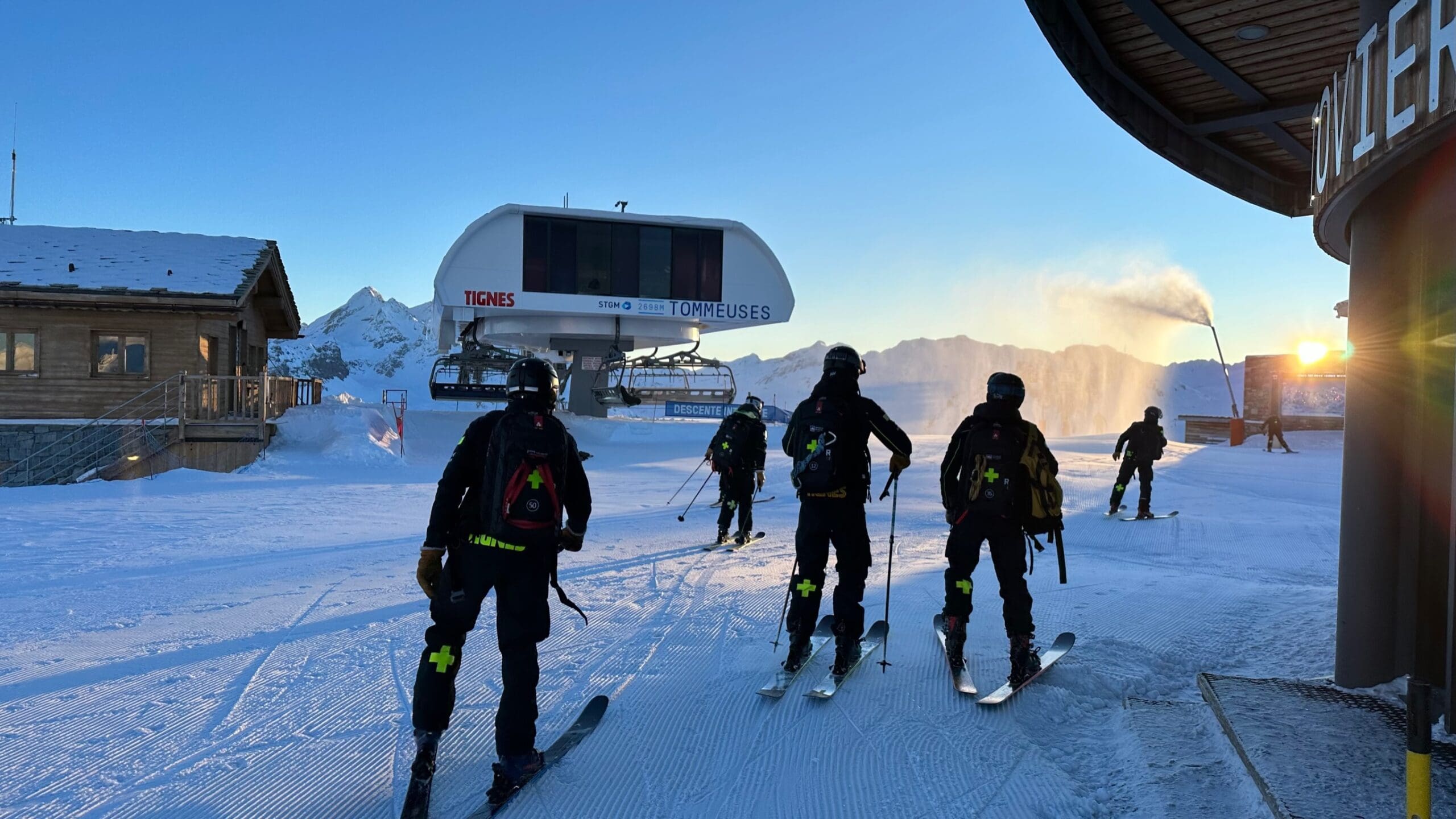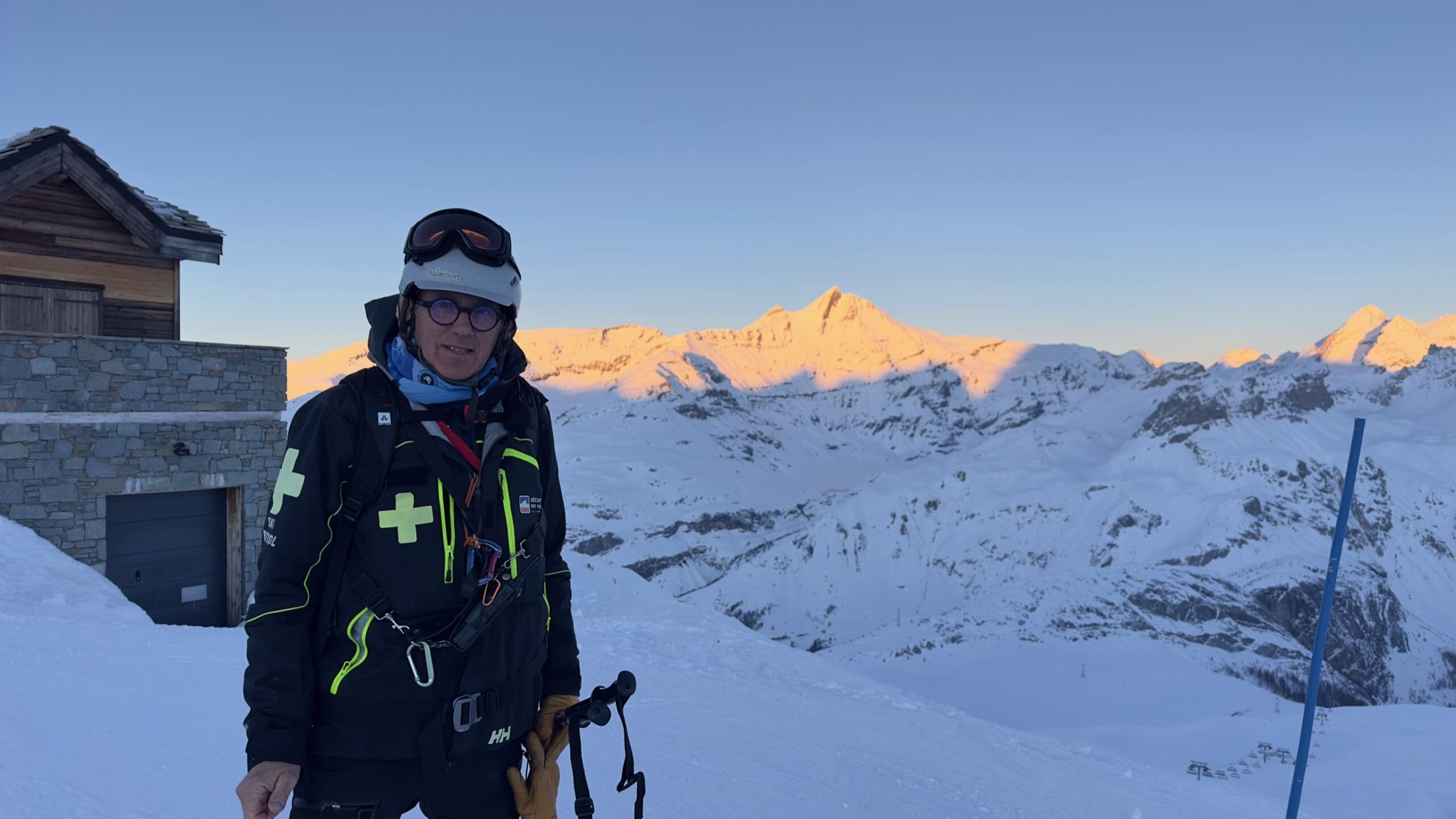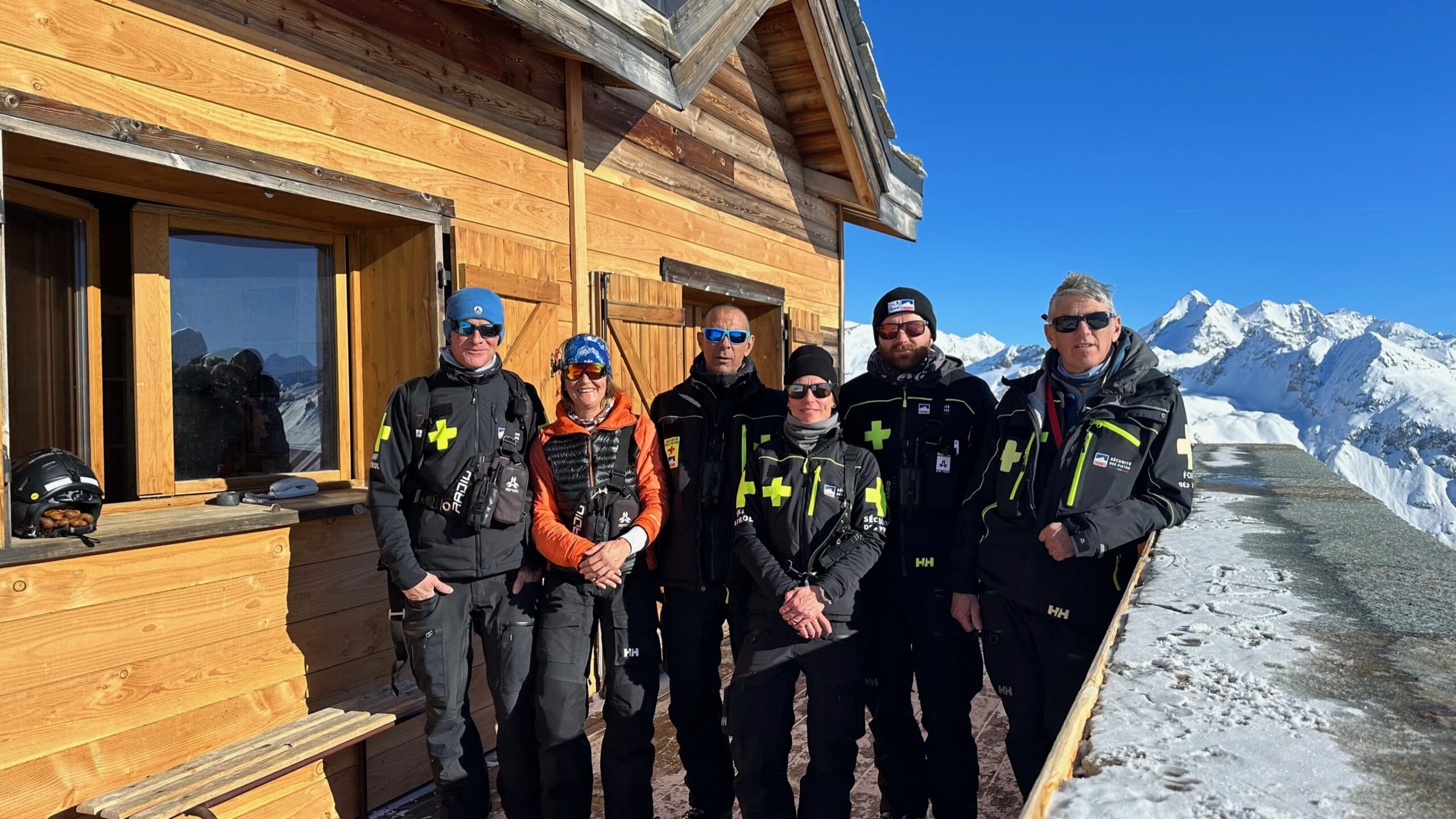How many of us regularly admire and marvel at the majesty of the mountains around us? What tiny percentage of us give any thought to the safety and security going on behind the scenes by the Mountain Patroller teams?
By Chris Glynne

10:20 Cont. As we grab our packs from the locker room, Pete explains about two others teams: the 5 snowmakers who run the 408 artificial snow cannons and the Gazex avalanche triggering team who are in command of the 41 big metal tubes you see on the steep mountain-sides.
The boy in me latches onto the ‘avalanche bombing’ and asks about Gasex vs. thrown dynamite. Pete is very clear that the Gasex are an easier/safer option, compared with pisteur thrown dynamite. However, they still need to monitor the results from nearby and occasionally the connectivity fails and they can’t be remotely triggered. I can’t help myself asking more about these activities and quickly become aware how, obviously, rigorous the procedures are. Not least the very extensive explosive training required but also the heavily scrutinised ‘PIDA’ procedures (Plan d’Intervention de Déclenchement des Avalanches) which have to be meticulously planned and executed. We talk about some of the very early morning starts for proactive avalanche controls; during or overnight from a storm. All of this is to safely open the mountain with as little disruption to our holidays as possible. I wince at the prospect of pre-5am starts in the cold, the dark… and the intrinsic danger all around let alone stored in your backpack.
I’m officially brain-numbed.
11:00 We leave HQ… my mind is almost literally spinning from the range and scale of the operation. This needs several articles to do it it full justice.
Pete decides it would be sensible to do a tour around the pistes checking for further dangers. En route we meet up with Arnaud, from the team, and compare notes again. There is a very friendly, almost family, feel with good humour but absolute focus on ‘customer safety’. This focus is not for show… you can tell from all the questions I ask about safety and enforcement that they are true to a culture of giving the customers the safest and best time possible.
12:00 We regroup at the hut… it’s a quiet day for rescues in our area – a bad day is ~10, a good day 1-2. Today is a very good day with ‘0’ so far. “Quiet for the team means nobody’s holiday has been ruined” says Pete.
12:30 There is time for a collective lunch gathering, even though they are still primed for any rescue calls. Marina is still on point duty.
They check equipment, they update the ‘to-do’ board, they talk like family over lunch. There is even time for keeping track of the Men’s SuperG race at Wengen.
I enquire about the backgrounds of the team:
- Jean-Pierre has had 42 years in Tignes; the first 3 with the STGM lift company, 39 years as a Pisteur.
- Fred has been in the game since 1988 – he’s been doing this for 37 years since age 16.
- Marina has a total of 25 years.
- Arnaud is just behind with 24 years.
- Mathieu has 14 years under his belt.
- Virginie is on 11 years.
- Gauthier is the newest member to the profession with 3 years over in Val d’Isere until moving to Tignes this season.
- And, of course, Pete who has done 18 years, covering all 4 of the Tignes sectors throughout that time.
Fabrice, Duncan and Marlene have days off today; so does Baptiste and his handsome rescue dog Nitro.
They come from quite varied backgrounds; fisherman, sailing instructor, etc.
Before the 1980s it was purely local men doing the job with much less training. It’s now both highly trained and diverse, with people from all areas. The common theme is a love of the outdoors.
13:30 We head off to check again on any new areas of improvement to be made. I offer to help with any grunt-work but it looks like all the remediation is either complete or in progress by the others. This time, Pete is also looking for other risks and improvements… maybe some feedback to the piste groomers for scraped areas needing additional snow. He tells me about the amazing satellite system which helps them map snow depths across every aspect of the pistes (to within 6cm). Once back to the hut he shows me the software and how it’s used. It makes a major difference in keeping the resort safer, preventing machinery damage but also preserving snow for longer seasons and less use of snow-cannons for environmental goals.
15:30 We start some final sweeps of runs for anything new that needs sorting. Other team members are checking or replenishing stocks of equipment at the various store rooms scattered around the mountain. Some are backfilling those mountain stocks from the enormous store at HQ, which I glimpsed earlier.
I ask more about the training in relation to qualifying and keeping their skills honed. The Continuous Professional Development (CPD) alone seems endless: avalanche rescue practise, medic first aid syllabus refresh, ‘grand vigour’ (large scale incident) practice, etc.
The qualification ladder brings home what a skilled profession this is. The entry level Premier Degrée feels like a University Degree qualification, the Deuxième Degrée perhaps a Masters level and Troisième perhaps PhD of mountain safety and rescue. Their first aid training alone sounds almost like a paramedic. This is beyond what most of us would experience in any professional walk of life.
16:00 The whole team congregate back at the hut. The more I ask the more I realise that the work they do during the Winter/Spring is merely the culmination of hard work put in during the Summer/Autumn. Jean-Pierre explains the mammoth task of ‘snow-farming’, to try to preserve year-on-year snow and prevent the glacial retreat caused by climate change. Pete reminds me of example projects he’s pointed out during the day: wood barricades that slow storm winds to collect snow in key areas; the piste re-profiling project to angle a major piste more obliquely to the Sun, prolonging cover into the spring. I learn about the team who ‘mow the lawn’ on all the pistes so the early season snowfall adheres to the ground rather than the mass of vegetation.
I ask Pete what keeps him doing this job. “Because it’s never finished” he replies. This isn’t flippancy. He explains that the mountain is always changing, risks evolving, stuff to be fixed… and people in need that he can help. The vibe is the same from the whole team.
16:30 It’s time to clear the terraces and interior of the Tovière Restaurant, to make sure customers head down the mountain. They ask if I’ve found the day useful. I tell them I loved it but I have no idea how I’ll fit all their work into a single story.
Mathieu and Arnaud inform me that I have an initiation to do… a sugar cube soaked in a spoon of Pear brandy, set alight then chomped without blowing out the flame. I’m unsure if the “Not to blow the flame out” is the norm, or if they’ve just made that up for me. For a moment I feel like part of this immense family.
I ask if they know there is 171 years of experience stood in this hut today… they have never counted that up before but they seem rightly impressed with their collective tally.
16:50 They close the hut for the night. I thank each of the team with special thanks to Jean-Pierre for allowing this day visit. I learn that in just 3 weeks he retires from this honourable profession. His deputy, Fred, inherits the role.
Each pisteur is allocated a final piste run to ensure all customers are safely down the mountain. On the way, they pull in all the safety banners so the piste groomers have a clear run overnight. I track down with Arnaud, on skis, whilst Pete follows behind on skidoo.
17:10 We’re all done at the base of the ‘Val Claret’ resort area – although two of the Tignes-wide crew are on-call overnight in case of any mountain callouts before the next morning’s shift.
I thank Arnaud and Pete, exclaiming hope that I can do even half the justice they deserve with this article. Humble and reserved, they both simply smile, shake my hand and tell me they hope I’ve had a good day and got what I needed. In a flash they head off on the skidoo… back to HQ to drop off the vehicle and their other kit.
17:15 I walk back home, exhausted from just listening to how they ensure we all have safe and enjoyable days on the mountain. I take a moment to soak up the beautiful sunset contrasting these majestic mountains. As though on cue, a piste basher twinkles into action near the Grand Motte peak, like the Evening Star. It drives home that this has just been one example day, which will imminently repeat… over 100 more times this season.
At the outset of my request, to shadow Pete, he set my expectations very clearly: “You will not be allowed to shadow the avalanche controlled bombing”. The child in me hid a ‘sad lip’ whilst the adult knew exactly why they would be so emphatic on this. Without doubt that is where they genuinely put their lives on the line to ensure our safety.
I knew that these teams of amazing people are quite literal life-savers in emergency events. Although we’ve had a ‘zero rescues’ day in our sector, they are primed for everything from bruises, strains, dislocations and breaks to cardiac distress/arrest, incapacity, getting lost or buried in an avalanche. What I was unprepared for was the scale of the collective team and wider breadth of their duty – informing us, protecting us and ensuring we have a fabulous time on the mountain in safety. It’s a safety that is only really challenged if we ignore all that effort. Even then they’ll come to our rescue.
Aside from the professionalism, I marvel at the empathy and sympathy for even the most simple of ‘issues’ that people get very upset by. Put simply, they want everyone to have the most fun possible on their holidays. Pete made the point that they are a part of a service industry… their part just happens to be based around safety and rescue. It is all the more sobering to hear that the Tignes Pisteurs team suffered 31 injuries, in the 2022-23 year, leading to 673 lost working days. On average, 10% of Pisteurs won’t see out the season, as a result of injury ‘in the line of duty’.
In private conversations with friends I had discussed whether there is a collective noun for Pisteurs, like the well known ‘pride of lions’ or ‘gaggle of geese’. One suggestion particularly resonated with us – a ‘Pantheon of Pisteurs’. After all, they really are heroes and I believe truly unsung heroes at that. I’ll certainly never forget what they do to enable my mountain passion, because their passion and motivation is to ensure we can enjoy ours.
I’m sure many of you have ended a week’s ski or board instruction and given your instructor a hug. Now, I’m not suggesting we all start skiing over to Pisteurs and freaking them out with such overt affection. The simplest way we can support and honour them is to enjoy our passion for the mountains in a safe and responsible manner so we minimise their rescue workload. However, I do advocate and encourage showing them some love in simpler ways. Say hello to them. Ask how things are going on the mountain. Pop into the hut and talk to them… and yes, tell them you appreciate what they do for us – both the seen and more particularly unseen. For my part, I hope this article illustrates my gratitude to them… but I took the team some local delicacy cakes just to be sure.






